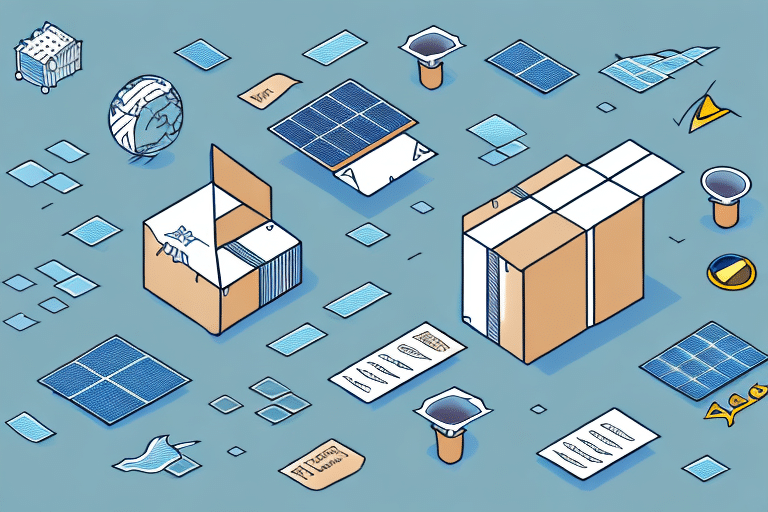How Sustainable Shipping Packaging Can Help Reduce Environmental Impact
In recent years, the volume of shipping packaging waste has been growing rapidly, leading to significant environmental impacts worldwide. This has prompted businesses and consumers alike to seek out more sustainable alternatives to traditional shipping materials. Sustainable shipping packaging provides an effective solution to this problem, significantly reducing the environmental footprint of shipping operations. In this article, we'll explore the importance of sustainable shipping packaging, the materials available, best practices, and the future of eco-friendly shipping solutions.
The Growing Problem of Shipping Packaging Waste and Its Environmental Impact
The volume of shipping packaging waste is staggering and continues to increase each year. According to the Environmental Protection Agency (EPA), in 2022, the United States generated approximately 107.6 million tons of municipal solid waste, with packaging and containers accounting for nearly 40% of this total. Traditional shipping materials, such as plastic and Styrofoam, take hundreds of years to decompose and contribute significantly to pollution in landfills and oceans.
Shipping packaging waste has serious environmental impacts, including air and water pollution, climate change, and harm to wildlife. Plastic packaging is particularly problematic, as it breaks down into microplastics that infiltrate marine ecosystems and pose threats to marine life and human health. By adopting sustainable shipping packaging materials, companies can substantially reduce their contribution to this growing environmental issue.
One effective solution is the use of biodegradable and recyclable materials. Materials made from cornstarch, recycled paper, cardboard, and bamboo can decompose more quickly and safely in the environment. By embracing these eco-friendly alternatives, companies can minimize their carbon footprint and contribute to the preservation of the planet for future generations.
The Importance of Sustainable Shipping Packaging: An Overview
Sustainable shipping packaging refers to materials designed to minimize environmental impact through biodegradability, compostability, and recyclability. The primary goal is to reduce waste generation and environmental degradation caused by traditional packaging methods. By selecting sustainable shipping packaging options, businesses and consumers play a critical role in curbing the proliferation of packaging waste and safeguarding the environment.
In addition to environmental benefits, sustainable shipping packaging offers significant economic advantages. Many consumers are increasingly willing to pay a premium for products that use eco-friendly packaging, leading to enhanced sales and stronger brand loyalty. Furthermore, sustainable packaging can lead to cost reductions in shipping by decreasing the weight and volume of packages, thereby lowering transportation costs and potentially resulting in more competitive pricing for consumers.
How Sustainable Shipping Packaging Can Help Companies Achieve Their Green Goals
Many companies are prioritizing sustainability and integrating eco-friendly practices into their operations. Sustainable shipping packaging serves as an accessible and effective method for companies to reach their green objectives while appealing to environmentally conscious consumers. By utilizing sustainable shipping packaging, companies can showcase their dedication to environmental stewardship and reduce the ecological footprint of their shipping activities.
Various sustainable packaging options are available, including biodegradable materials, recycled resources, and reusable containers. Biodegradable materials, such as plant-based plastics, naturally decompose without contributing to plastic pollution. Recycled materials like cardboard and paper lessen the demand for virgin resources and can be recycled again after use. Reusable containers, such as metal or glass, offer multiple uses and negate the need for disposable packaging. Implementing these sustainable solutions allows companies to make a positive environmental impact and progress toward a more sustainable future.
The Benefits of Using Sustainable Shipping Packaging for Businesses and Consumers Alike
The advantages of sustainable shipping packaging extend to both businesses and consumers. For businesses, adopting eco-friendly packaging materials can lead to significant cost savings, especially as the cost of traditional packaging continues to rise. Additionally, many consumers prefer to purchase from companies that prioritize sustainability, potentially boosting sales and enhancing brand reputation.
For consumers, choosing products packaged in sustainable materials helps diminish the carbon footprint associated with their purchasing decisions. By supporting products with eco-friendly packaging, consumers contribute to reducing the escalation of packaging waste and promote environmental conservation.
Furthermore, adopting sustainable shipping packaging enables businesses to comply with increasingly stringent environmental regulations. Many countries have introduced laws mandating reductions in environmental impact, including requirements for sustainable packaging materials. By utilizing eco-friendly packaging, businesses can avoid fines and penalties associated with non-compliance.
Sustainable shipping packaging also enhances product safety during transit. Eco-friendly materials often offer greater durability, providing better protection for products and reducing the incidence of damage during shipping. This can lead to fewer returns and refunds due to damaged goods, ultimately saving businesses money.
The Different Types of Sustainable Shipping Packaging Materials Available Today
There is a diverse range of sustainable shipping packaging materials available in the market today, each offering unique benefits for environmental sustainability:
- Biodegradable Plastics: Made from natural materials like corn starch, these plastics break down naturally in the environment, reducing long-term pollution.
- Paper-Based Materials: Kraft paper and cardboard are excellent alternatives to traditional plastic packaging, offering high recyclability and biodegradability.
- Plant-Based Materials: Bamboo, sugarcane, and other plant-based materials are both biodegradable and compostable, providing sustainable alternatives to conventional packaging.
- Mushroom-Based Packaging: An innovative option, mushroom-based packaging utilizes mycelium—the root structure of mushrooms—to create biodegradable and compostable packaging that can even serve as natural fertilizer.
In addition to the materials themselves, sustainable shipping packaging involves strategies to reduce waste and optimize packaging design. This includes minimizing packaging size, optimizing package weight and dimensions, and incorporating reusable or recyclable materials. By adopting these practices, businesses can not only lessen their environmental impact but also achieve cost savings in their shipping processes.
Biodegradable vs. Compostable: What's the Difference and Which is Better for Shipping?
While the terms "biodegradable" and "compostable" are often used interchangeably, they refer to different processes and outcomes. Understanding the distinction is key to selecting the appropriate packaging material for shipping:
- Biodegradable: These materials break down into natural substances like water, carbon dioxide, and biomass over time through microbial activity. However, the timeframe and completeness of decomposition can vary, and not all biodegradable materials will fully break down in natural environments.
- Compostable: Compostable materials are designed to break down fully and rapidly under specific composting conditions, typically within 90 days. They convert into nutrient-rich compost that can enhance soil health.
When it comes to shipping, compostable materials are generally preferable as they are guaranteed to decompose completely and have a minimal environmental impact. However, it's important to note that not all compostable materials are created equal. Some require specific conditions, such as controlled temperature and moisture levels, to break down effectively. Businesses should research and select compostable materials that align with their shipping needs and the capabilities of local composting facilities.
Additionally, using biodegradable or compostable materials can serve as a unique selling point for businesses. As consumers become more environmentally conscious, they increasingly seek out products and companies that prioritize sustainability. Eco-friendly shipping materials can attract these consumers and distinguish businesses from competitors.
How to Choose the Right Sustainable Shipping Packaging Solution for Your Business Needs
Selecting the appropriate sustainable shipping packaging solution is essential for effectively meeting both environmental and business objectives. Consider the following factors when choosing your packaging materials:
- Specific Needs and Goals: Determine whether your priority is cost savings, environmental impact, product protection, or a combination of these factors.
- Durability and Protection: Ensure that the chosen materials provide adequate protection for your products during transit without compromising sustainability.
- Recyclability and Biodegradability: Opt for materials that can be easily recycled or biodegrade without harming the environment.
- Carbon Footprint: Assess the overall environmental impact of the packaging materials, including the resources required for production and transportation.
- Cost-Effectiveness: Balance the cost of sustainable packaging with the long-term benefits and potential savings in shipping expenses.
By carefully evaluating these aspects, businesses can select sustainable shipping packaging that aligns with their values and sustainability goals while meeting operational requirements.
Best Practices for Sustainable Shipping Packaging: Tips and Tricks for Success
Implementing sustainable shipping packaging practices can significantly contribute to environmental preservation and operational efficiency. Here are several best practices to consider:
- Reduce Packaging Size: Optimize the size and weight of packaging materials to minimize waste and lower shipping costs.
- Use Recyclable or Compostable Materials: Select packaging materials that can be easily recycled or composted, reducing the environmental impact.
- Partner with Eco-Friendly Suppliers: Collaborate with suppliers who prioritize sustainability to ensure a consistent and eco-friendly supply chain.
- Implement Minimalist Packaging Designs: Simplify packaging designs to use only the necessary materials, thereby reducing waste and costs.
- Use Renewable Resources: Incorporate materials like bamboo, cornstarch, or mushroom-based packaging that are renewable and sustainable.
- Adopt Reusable Packaging: Consider using packaging solutions that customers can reuse, such as returnable containers or refillable packaging.
By adhering to these best practices, businesses can effectively implement sustainable shipping packaging that benefits both the environment and the bottom line.
How to Educate Your Customers on the Importance of Choosing Eco-Friendly Packaging Options
Educating customers about the significance of eco-friendly packaging is crucial for fostering sustainable consumption habits. Here are strategies to effectively communicate the benefits of sustainable packaging to your customers:
- Marketing and Advertising Campaigns: Highlight your commitment to sustainability through targeted marketing efforts that emphasize the environmental benefits of your packaging choices.
- Educational Content on Websites: Provide detailed information about the materials used in your packaging and the positive impact they have on the environment through blog posts, articles, or dedicated sustainability pages.
- Clear Labeling on Packaging: Include explicit labels on your packaging that indicate whether the materials are recyclable, biodegradable, or compostable, helping customers make informed disposal decisions.
- Engage Through Social Media: Utilize social media platforms to share stories, updates, and the importance of sustainable packaging, engaging with customers and encouraging them to participate in sustainability efforts.
- Transparency: Be open about your sustainability goals, progress, and challenges, building trust with customers and demonstrating your genuine commitment to environmental responsibility.
By implementing these educational strategies, businesses can increase customer awareness and demand for eco-friendly packaging options, driving broader adoption of sustainable practices.
Real-Life Examples of Companies Successfully Implementing Sustainable Shipping Practices
Numerous companies have set exemplary standards in adopting sustainable shipping practices, demonstrating that environmental responsibility and business success can go hand-in-hand:
- Patagonia: An outdoor clothing company known for its environmental advocacy, Patagonia uses 100% recycled and recyclable packaging materials, minimizing waste and promoting sustainability throughout its supply chain.
- Plaine Products: This beauty products company employs refillable aluminum bottles, significantly reducing plastic waste and encouraging customers to reuse packaging.
- IKEA: IKEA is committed to using sustainable materials across its product range, including shipping packaging made from recycled paper and cardboard, and exploring innovative solutions like mushroom-based materials.
- Amazon: Through its "Frustration-Free Packaging" program, Amazon encourages manufacturers to use packaging that is easy to open, recyclable, and made from sustainable materials, reducing packaging waste and improving customer satisfaction.
- Loop by TerraCycle: Loop is a global recycling platform that partners with major brands to offer reusable packaging solutions, allowing consumers to return containers for cleaning and reuse, thereby eliminating single-use packaging.
These companies illustrate the feasibility and benefits of transitioning to sustainable shipping practices, serving as models for others aiming to reduce their environmental impact.
The Future of Sustainable Shipping Packaging: Emerging Trends and Innovations to Watch
The future of sustainable shipping packaging is poised for significant advancements, driven by increasing environmental awareness and technological innovation. Key trends and emerging technologies include:
- Edible Packaging: Innovations in edible packaging, such as seaweed-based materials, offer completely biodegradable options that can eliminate waste entirely.
- Advanced Biodegradable Materials: Development of new biodegradable and compostable materials that mimic the protective qualities of traditional plastics while breaking down more efficiently in natural environments.
- Smart Packaging: Incorporation of smart technologies, such as QR codes and RFID tags, that provide information on recycling and disposal, enhancing consumer engagement and proper waste management.
- Circular Economy Models: Transitioning to circular economy models where packaging is designed for reuse and recycling, ensuring materials remain in use and out of landfills for as long as possible.
- 3D-Printed Packaging: Utilizing 3D printing technology to create customized, lightweight, and eco-friendly packaging solutions tailored to specific products, optimizing material usage and reducing waste.
As demand for sustainable packaging continues to grow, these innovations will play a critical role in shaping the future of shipping, making it increasingly eco-friendly and resource-efficient.
Conclusion
Sustainable shipping packaging is a pivotal solution to the escalating issue of shipping packaging waste. By adopting eco-friendly materials and implementing sustainable shipping practices, businesses and consumers can significantly diminish their environmental impact and contribute to the preservation of the planet. The benefits of sustainable shipping packaging are multifaceted, encompassing environmental protection, economic savings, and enhanced brand reputation. With ongoing innovations and a growing emphasis on sustainability, the future of shipping packaging looks promising. By valuing and prioritizing sustainable practices, we can collectively work towards a more environmentally-conscious and sustainable future for everyone.






















